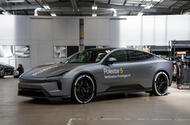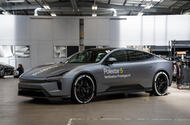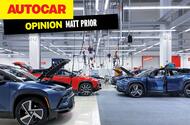Opinion
“Car Makers Racing to Offer Discounts Over £20k on EVs | Giga Gears Editor’s Letter”

The biggest discount on any EV right now is £21,395 off the Audi E-tron GTGiven the tough market conditions, car makers are turning to big discounts to help hit mandated EV sales targets
Average discounts for new electric cars in the UK now exceed those for petrol cars – a watershed moment in the new car market’s race to hit a mandated 22% of sales as electric cars in 2024.
The recent half-year registrations data from the SMMT revealed a market share of 16.6% for electric cars so far in 2024 - just half a percentage point ahead of 2023 - although demand was stronger in June, at 19%.
However, the UK’s new car market must now overperform for the rest of the year to make up lost ground and hit that magical 22% mark. Remember, car makers will be fined for missing this target, as laid out in the ZEV mandate legislation.
With interest rates and the cost of living still high, consumer confidence still low, electric car prices seen as too expensive and no support from either the previous or new governments forthcoming, the only real play left for car makers is to discount prices themselves.
According to What Car? Target Price data, the average total cash and finance discount on a new electric car is now 9.9%, compared with 9.6% for petrol cars. This works out at an average of £5856 off the price of a new electric car in the UK.
Dig deeper into individual models and you’ll get an insight into who has more work to do than others in shifting electric cars to hit that target. Mazda is the biggest electric car discounter, with a whopping 24.5% on average (£7353) being offered on its MX-30 range, while Stellantis brands Vauxhall (16.9% discount, or £6251 per car) and Fiat (14%, £3407) follow closely behind.
Ford has said it may have to restrict the supply of sales of non-electric cars in order to hit the ZEV mandate, yet it is still trying hard to shift the Mustang, with discounts of £9403 on offer.
The biggest individual discount on offer on any electric car is the £21,395 buyers can get off the Audi E-tron GT, although that’s shy of the £27,441 you can get off a BMW M8, the highest discount of any car on sale when all fuel types are considered. Still, for the biggest savings on offer, electric or otherwise, head to Audi and BMW dealers, as five-figure discounts are commonplace at these ‘premium’ brands.
Discounting disappeared from the new car market with Covid and the subsequent semiconductor chip shortage, which limited supply. Car makers pledged discounting would not to return, particularly with the then expected rise of agency sales, meaning fixed prices and the end of haggling.
Perhaps that might have held in a normal market, but there’s no such thing as normal any more. These, though, are discounts with a difference. That's because they come at a time when established car makers are more squeezed than ever, being dictated by legislation towards a technical solution in the form of battery-electric vehicles that cost a fortune to develop yet are being shunned by consumers and not supported by legislators who asked for them in the first place.
Stellantis is one car maker that has been particular scathing of the ZEV mandate, with boss Carlos Tavares recently calling it “a terrible thing for the UK”.
Given Stellantis has said it has little choice but to comply, you can see Tavares’ point: he’s supporting two factories in the UK, employing thousands and investing millions, yet at the point of sale he’s likely to be losing money. Such is the folly of this increasingly botched-looking shift to EVs in the UK.
Polestar vs Lotus: Who Will Come Out on Top?

Polestar will soon release its own Taycan competitor in the form of the snouty 5Unlike the new Emeya, the upcoming Polestar 5 has the engineering hallmarks of an old-school Lotus
A fews week ago I was in Austria to have a go in the Lotus Emeya – an electric super-saloon with as much as 904bhp and a good dollop more interior space than you get in the Porsche Taycan, especially in the back.
If you can make peace with the fact that it’s a Lotus that treads as heavily as a V8 turbodiesel-equipped L322-generation Range Rover (not easy, I'll admit), the Emeya is actually quite a decent thing. It's no reincarnated Carlton but it has some likeability about it.
And yet, out in the Tyrolean wilds, with the Emeya S (that’s the less powerful one, with a pitiful 603bhp) making a fair case for itself with fine steering and fluid handling, as a product it still had the whiff of a pulled punch about it. I couldn’t put my finger on why, but I have done since. It’s partly down to…Volvo.
Well not Volvo strictly but Polestar, which began life as the Swedish marque's performance EV subsidiary (but is now a standalone firm within the Geely empire).
Polestar will soon release its own Taycan competitor in the form of the snouty 5. As a purely electric car, it'll be horribly heavy, just like the 2.5-tonne Emeya. However, unlike the Emeya, it’s being developed in the UK, by a crack team of engineers who have devised for it a bonded-aluminium chassis with ‘supercar’ stiffness.
This team, based at the MIRA proving ground near Nuneaton, has also been given free reign to develop the axle and steering systems from the ground up. The car will be low-slung and deliberately devoid of complex, electronics-reliant hardware, such as active anti-roll bars, rear-steering and air springs, all of which the Emeya gorges on.
The 5 will be an unusual Polestar in that it sets out to be a seat-of-your-pants drivers’ car. The conception sounds quite Lotusy, too, doesn’t it?
In a way, the 5 will be a four-door Evora EV. And this is where things get perplexing. Volvo and Polestar are ultimately controlled by Chinese conglomerate Geely. The same company also owns Lotus. All three brands exist under the same umbrella, so any resource developed by one entity to one can be made available to another.
What I’m therefore wondering is why the unapologetically design-led Polestar brand is taking a bespoke, purist engineering approach for its Taycan fighter while the Emeya, coming from a company whose name has hitherto been synonymous with machines of unfettered synaptic delight, has ended up sharing its platform, albeit modified, with the Zeekr 009 and the Smart #1.
The Emeya is good – better than many will judge it to be, having never even driven it. But it could have been considerably more Lotusy if the team behind it (based near Frankfurt, as it happens, not Hethel) had been allowed to take the 5 approach. Or at least use the 5 platform.
Instead, what’s happened seems akin to Audi being allowed to develop a clean-sheet honey of a chassis for the TT while Porsche has to adapt a VW Golf platform for the Boxster. Make it make sense.
“Volvo vs Lotus: Who Will Outperform?”

Polestar will soon release its own Taycan competitor in the form of the snouty 5Unlike the new Emeya, the upcoming Polestar 5 has the engineering hallmarks of an old-school Lotus
A fews week ago I was in Austria to have a go in the Lotus Emeya – an electric super-saloon with as much as 904bhp and a good dollop more interior space than you get in the Porsche Taycan, especially in the back.
If you can make peace with the fact that it’s a Lotus that treads as heavily as a V8 turbodiesel-equipped L322-generation Range Rover (not easy, I'll admit), the Emeya is actually quite a decent thing. It's no reincarnated Carlton but it has some likeability about it.
And yet, out in the Tyrolean wilds, with the Emeya S (that’s the less powerful one, with a pitiful 603bhp) making a fair case for itself with fine steering and fluid handling, as a product it still had the whiff of a pulled punch about it. I couldn’t put my finger on why, but I have done since. It’s partly down to…Volvo.
Well not Volvo strictly but Polestar, which began life as the Swedish marque's performance EV subsidiary (but is now a standalone firm within the Geely empire).
Polestar will soon release its own Taycan competitor in the form of the snouty 5. As a purely electric car, it'll be horribly heavy, just like the 2.5-tonne Emeya. However, unlike the Emeya, it’s being developed in the UK, by a crack team of engineers who have devised for it a bonded-aluminium chassis with ‘supercar’ stiffness.
This team, based at the MIRA proving ground near Nuneaton, has also been given free reign to develop the axle and steering systems from the ground up. The car will be low-slung and deliberately devoid of complex, electronics-reliant hardware, such as active anti-roll bars, rear-steering and air springs, all of which the Emeya gorges on.
The 5 will be an unusual Polestar in that it sets out to be a seat-of-your-pants drivers’ car. The conception sounds quite Lotusy, too, doesn’t it?
In a way, the 5 will be a four-door Evora EV. And this is where things get perplexing. Volvo and Polestar are ultimately controlled by Chinese conglomerate Geely. The same company also owns Lotus. All three brands exist under the same umbrella, so any resource developed by one entity to one can be made available to another.
What I’m therefore wondering is why the unapologetically design-led Polestar brand is taking a bespoke, purist engineering approach for its Taycan fighter while the Emeya, coming from a company whose name has hitherto been synonymous with machines of unfettered synaptic delight, has ended up sharing its platform, albeit modified, with the Zeekr 009 and the Smart #1.
The Emeya is good – better than many will judge it to be, having never even driven it. But it could have been considerably more Lotusy if the team behind it (based near Frankfurt, as it happens, not Hethel) had been allowed to take the 5 approach. Or at least use the 5 platform.
Instead, what’s happened seems akin to Audi being allowed to develop a clean-sheet honey of a chassis for the TT while Porsche has to adapt a VW Golf platform for the Boxster. Make it make sense.
Fixing a Car from a Defunct Manufacturer | Giga Gears

Fisker finally filed for Chapter 11 bankruptcy in JunePrior riffs on the demise of Fisker and how maintaining software is now a manufacturer’s ongoing responsibility
With somewhat unfortunate timing from our point of view, the Fisker Ocean nipped into Autocar’s 100 Best New Cars list in April, just as its maker ran into terminal financial trouble.
A few weeks on, nice though the Ocean is, it wouldn’t make it into our most-recommended cars list any more. Due apologies to anyone who pressed the button on buying one as a result of its 98th-place finish.
American magazine MotorTrend took delivery of a long-term test Ocean – which, if you will forgive me for talking shop for one more minute, reminded me of MG Rover’s 2005 demise.
Autocar had an MG ZT on long-term test at the time, and ultimately it stayed around for… a while. Beyond remembering that it was here for several months before the receivers got in touch to enquire about its whereabouts, our recollections about how long it was here for and what we did with it are a bit hazy 19 years on.
We didn’t have the V5C, so we couldn’t have retaxed it when that ran out, and while we could have insured it and probably did, to whom would we have reported anything untoward happening to it? So long-term reports on it dried up pretty sharpish, and I suppose it occupied a 4.7-metre-long space in the office car park until someone with a clipboard came to collect it.
From thereon, it would’ve been sold into the used market and its life would’ve been relatively straightforward – at least until 2012, when, if I’ve identified the correct car in our digital archive, its MOT expired.
When MG Rover went under, so too did warranties and manufacturer support for this car, of course, but it was a mechanical device largely made from well-known components. If you pop its registration number into the Halfords website, it will still suggest the right oil filter for that engine today, and you can collect one from your local branch within three hours.
There are plenty of ZTs, Rover 75s and other MG Rover creations easing their way towards classic status, still happily supported by independent garages.
What, though, would happen to a thoroughly modern car? The way cars work has changed, regardless of how they’re powered, with software replacing hardware not just for infotainment systems but frequently driving-critical ones too.
Some Volvo EX30 owners have rejected their cars for a refund as a result of software failures, and our long-term Jeep Avenger Electric wasn’t alone in having its software brick itself, with an official repairer unable to trace the fault.
In the past, the manufacturer would in effect sell a car and hand responsibility for it over to its dealer network for repairs and maintenance. These days, maintaining software and updating it seems part of the manufacturer’s ongoing responsibility – and there’s a limit to how much it can open up access to the software, because of cybersecurity fears.
Every new car I run now will occasionally want to update its operating system, and it all comes from the mothership.
There are ways, I understand, to make software exceptionally robust. That’s why airliners so rarely fall from the sky. But this is also exceptionally expensive. So who fixes what could eventually end up being unfixable?
If two of the world’s biggest car companies – Volvo owner Geely and Jeep owner Stellantis – can’t keep a new car on the road right now, what chance does the local independent garage at the end of your road have in 10 years’ time?
Chinese Brands Shine at Goodwood Car Show

MG's centenary celebrations included taking over the Festival of Speed's central featureThe 2024 Festival of Speed will be remembered for the Chinese presence, with MG taking centre stage
The UK hasn’t had its own official motor show for many years, but in its place the Goodwood Festival of Speed has emerged as the industry’s premier meeting place.
While Goodwood is at its core a live event for the paying public rooted in motorsport, the support of car manufacturers and their seizing of the opportunity to present their latest models has allowed for wider industry trends to be played out.
And Goodwood 2024 will be remembered as the edition when Chinese car companies parked on the lawns of the Duke of Richmond’s estate in West Sussex.
Like with almost every other major industry event in recent months, the huge presence of Chinese car manufacturers was impossible to ignore. This felt different, though. This was not industry professionals wandering around show halls: this was in full public view, with the Chinese brands given prime spots and presented equally alongside much more familiar and established names.
MG went all in and made itself the marque at the centre of the Festival with the main statue to mark its centenary, while the likes of Omoda, Hongqi and BYD (who else?) also had a significant presence.
Each did so for different reasons. MG’s play on its history belies that it’s British in name only, yet what better place to remind people of what you used to be than at somewhere where the informed, engaged and influential audience will remember it?
The reason behind Hongqi, China’s answer to Rolls-Royce and Bentley, being at the show was less clear, although Goodwood is exactly the sort of place where you can legitimise a brand, given the equal footing and neutral branding each marque is given for their presenting space at Goodwood. Likewise, as the cars go up the hill one by one, there are no other distractions and the airtime is just the same as that of a revered old Formula 1 car from Ayrton Senna. Or indeed the latest Rolls-Royce…
Indeed, Hongqi delayed its press conference to give a tour of its stand to the Duke, under the watchful eye of ex-Rolls-Royce designer Giles Taylor, who swapped Goodwood for Changchun six years ago. It summed up both the surrealism and the sheer pace of change for such a brand to be able to command such an audience. Then again, its pockets are probably quite deep.

BYD vice president Stella Li said the company was there because “Goodwood is the place where cars are faster, more unique and have more fun”. Can it translate into sales? “I think so. You can see that all our stage is full of people,” she said.
What did those people think? After all, Goodwood itself is a business, and adding in brands most people have never heard of to the spectacle carries risk. So we asked some show goers what they thought.
A few themes were prominent among the people we spoke to: the quality of the cars, concerns about privacy and security of data, the potential lack of dealer support and networks if anything goes wrong, and picking the best marques from the sheer volume of new entrants arriving from China.
“The initial impression is very good,” said transport manager Andy Green on the quality of the cars. “One’s very conscious of saying that Chinese stuff looks cheap. Nothing here looks cheap today. Everything looks of good build quality. Everything’s put together well. I haven’t seen anything malfunction. I haven’t seen anything not working.”
Conversely, police officer Sam Fenton had less luck. “We sat in a Yangwang earlier and it had already popped up with a dealer fault. I thought: ‘Ah, good start to your presentation…’.”
The branding of the cars also seemed largely well received, although camera specialist Elliott Marris highlighted an issue that Chinese brands face: “I feel like there’s a stigma to overcome if the Chinese want to be serious players. But I haven’t really had the chance to have exposure to them. My first impression is that they look like nice pieces of design. I feel like more people seeing them will help them be more open to the idea of buying a Chinese car.”
Fenton gave the best summary of the chicken-and-egg situation currently confronting Chinese brands: “I think it’s difficult for any manufacturer because you’re introducing something new, and you have to gain trust, and you gain trust and popularity through presenting at events like this today.
“I don’t think BYD has done anything wrong at all. There are just so many Chinese car brands. We’re looking at Yangwang; MG’s now owned by a Chinese company. I just think it’s a bit of an awkward spot. I don’t think there’s enough of an infrastructure for them to be trustworthy just yet. I’d love to be proved wrong: if they can prove they’ve got the whole package, tech, space, range and the dealer backing, then it’s golden.”
